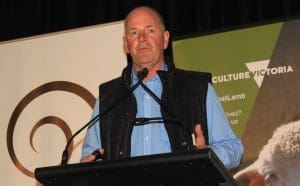
Robert Herrmann at the 2018 BestWool BestLamb Conference
AUSTRALIA’S wool industry should not be throwing large amounts of money at marketing with wool prices at record levels, producers were told at the 2018 BestWool BestLamb Conference in Bendigo this week.
With a declining Merino flock and wool production, AgConcepts Advisory managing director and Mecardo publisher Robert Herrmann said the industry needed to throw as much of its levy funds as possible at on-farm research and development “where the rubber is going to hit the road,” and especially into new shearing innovations.
He proposed that the current Australian Wool Innovation levy split of 60 percent on marketing and 40pc on research and development be flipped to support more on-farm developments.
Mr Herrmann also asked sheep and wool producers at the conference to give innovation a chance on their farms. He said despite falling grain prices, productivity and supply in the world cropping sector was still growing, mostly matching population growth.
“So how have they done it? So the grain industry has maintained their call to the people who are looking for exciting farming exercises by increasing productivity, engaging in technology – machinery, fertiliser, chemical and cropping systems – and they’re actually reducing the real cost per tonne.
“Which is what you’ve got to do, because our real commodity price per tonne is decreasing.”
Mr Herrmann said cropping and prime lamb production were contesting wool for acres. The challenge for the sheep industry in Australia was to stop the decline in Merino wool and sheep numbers.
“Number two, win some acres back.
“We’ve got to get the next generation engaged at a greater level,” he said.
Wool harvesting is the ‘sleeper in the room’
Mr Herrmann said the “sleeper in the room” was investment in wool harvesting.
“We must do something about wool harvesting and I am fearful that we might almost be too late.
“I know there are things in the pipeline and I am excited about that,” he said.
“We had a chance at this in 1980, we had a robot and what happened, the robot couldn’t shear as fast as the shearer so we told the robot to piss off.”
Mr Herrmann said innovation isn’t science and technology, but rather the application of science and technology.
“And it is done by people ….. innovation is what happens in your business.”
He urged producers that when a new idea to shear or other technology is proposed to give it a chance.
“If disagree with me then show me whose grandkids are going to be shearers in 20 years’ time – you show me where they are.
“If you do agree with me then when the new innovation comes, when the new idea comes out….because adversity breeds innovation… then you must support it,” he said.
“Don’t say no, we tried that before… we have to actually embrace it and that’s where we can influence our industry bodies.”
He said producers should make sure the industry bodies understand where their problems are and when they bring forward things “get behind it, give it a go.”
“Other industries are very good at doing, we as farmers are very good at being cynical and this is not a time for it; we need to embrace new ideas and change.
“As a busted arse shearer I am begging you,” Mr Herrmann said.
“What I am telling it that we haven’t got a lot of time, so when the idea comes, when the innovation and it is not far away, give it a go, embrace it, support it, be positive.”
AWI media manager Marius Cuming said the next The Yarn podcast would include some interviews with robotic experts after they met with shearing experts.
“So we are having another look at it.”
What’s next? Herrmann vs robotic shearer
Mr Herrmann proposed a shear-off between him and a robot, if AWI was to bring a prototype to the next conference, to illustrate the potential of technology.
“And we will make the robot look bloody good.
“We have to go into these things with a wide lens – an open mind –and remembering that most innovations in their first effort aren’t right,” he said.
“It’s what you learn from that first effort and then add and persist and carry on.
“You’ve heard about exponential learning and that’s what’s happening today; what we know today, we know tens of times more in a short period of time,” Mr Herrmann said.
“Technology has answers for us and we’ve got to find answers to these problems.”

The Robotic Shearing Machine developed by Australian Merino Wool Harvesting Pty. Ltd. is now owned by the Museum of Applied Arts and Sciences. Details are on their web site under Automated Wool Harvesting.It is located in the Sheep’s Back Museum in Naracoorte, SA.
It was able to do the same speed as a slow- to moderate speed 3 stand shed. It used three staff, as opposed to five for the three stand shed. It was a complete harvesting system and did a high quality job. Operators did not need to be as skilled as shearers.
AMWH believed that development of the harvester was complete, but greater speed was needed and could be achieved. They had plans made for a new machine, but with the downturn in the wool industry, they were unable to obtain further development finance. Thus there is potential for further development.
Robert has covered the importance of finding an alternative to the traditional shearing as we know it now. I have recently read a paper on an alternative to shearing that has nothing to do with robotics and would tick every box for defleecing sheep and lambs. If was initially funded by AWI and the funding was withdrawn in 2015, which is unbelievable.